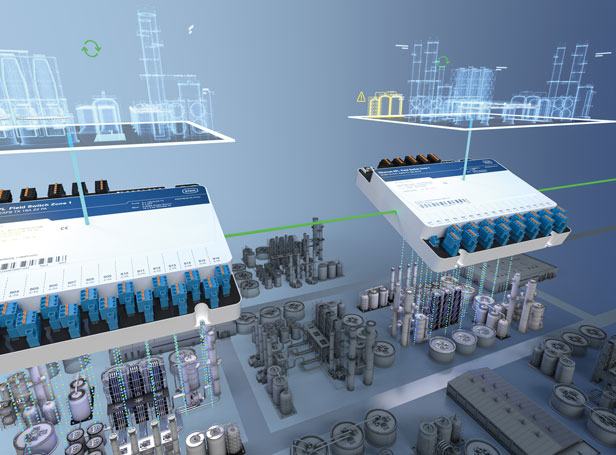1. What are safety barriers?
Safety barriers (also known as Zener barriers) are used to connect intrinsically safe circuits (Ex i) and non-intrinsically safe circuits, such as Ex i field devices with automation systems. They can process standard signals such as 4 to 20 mA, as well as less common ones. There are many safety barriers which have been specifically developed for certain applications.
The barriers use a combination of Zener diodes, resistors and fuses to limit the electrical energy that enters the hazardous area with reference to their ground connection. Safety barriers are characterised by a very extensive application area.
2. Application
Safety barriers are used as cost-effective isolators without galvanic separation between intrinsically safe and non-intrinsically safe circuits. Their function is to protect electrical circuits (i.e. cables and apparatus) that are installed in hazardous areas.
Safety barriers are considered associated apparatus. An intrinsically safe circuit always consists of intrinsically safe apparatus (field device) and associated apparatus (safety barrier, isolator, remote I/O, etc.). As associated apparatus, safety barriers form the bridge between the intrinsically safe circuit and the non-intrinsically safe circuit. Depending on the application, it may be necessary to use multiple devices in a single connection.
Since safety barriers also contain non-intrinsically safe circuits, they either have to be installed outside the hazardous area or, if suitably certified, in Zone 2/Division 2. The use of another type of protection (e.g. flameproof enclosure) makes it possible to install the safety barriers in Zone 1.
3. Function
The function of safety barriers is to limit the power fed into an intrinsically safe circuit so that ignition is prevented, whether due to sparks or thermal effects (hot surfaces).
A safety barrier has three main elements for this purpose:
- Zener diode to limit voltage
- Resistor or semiconductor component to limit current
- Fuse to protect the Zener diode
R. STAHL Series 9001, 9002 and 9004 safety barriers also contain a protective circuit with an interchangeable back-up fuse which is accessible from the outside and protects the inaccessible internally encapsulated fuse of the safety barrier. The protective circuit prevents both fuses tripping at the same time.
To cover the entire range of automation technology applications, some safety barriers contain function blocks like electronic current limiting, amplification, etc.
4. Equipotential bonding / grounding
Potential differences may render intrinsic safety and therefore explosion protection ineffective, as safety barriers do not have galvanic separation between the input and output. All (national) standards for setting up intrinsically safe circuits therefore stipulate that:
- Equipotential bonding or a grounding system must be present and
- Safety barriers must be connected to this equipotential bonding
Safety barriers from R. STAHL can alternatively be connected to the equipotential bonding either directly via the electrically conductive snap-on mechanics or using the /equipotential bonding terminal.
For electrical or measurement reasons, an ungrounded circuit may be necessary. An ungrounded circuit can in general be created by using a two-channel safety barrier or by connecting two single-channel safety barriers.
Grounded electrical circuit
Ungrounded electrical circuit
Even if the circuit is "ungrounded" or the safety barrier has been designed to be isolated from the DIN rail using the clamping bases available as accessories, safety barriers must always be connected to /equipotential bonding.
It must also be ensured that the connection to /equipotential bonding is less than 1 Ω. National regulations may have stricter requirements.
5. Mounting
R. STAHL Series 9001, 9002 and 9004 safety barriers are set apart by their exceptional ease of installation. They are snapped directly on to a 35 mm DIN rail (NS 35/15) without a mounting attachment. At the same time, this creates a conductive connection between the /equipotential bonding connection of the safety barrier and the rail. Multiple safety barriers are grounded by connecting the rail to the actual equipotential bonding/grounding system (collective grounding).
Alternatively, it is also possible to ground the safety barriers individually. The /equipotential bonding terminal is provided on the intrinsically safe connection side of the safety barrier for this purpose.
Interchangeable back-up fuse
R. STAHL's safety barriers feature an interchangeable back-up fuse. Two-channel barriers have one back-up fuse for each channel. The back-up fuse is connected upstream of the internal, inaccessible fuse. A protective circuit prevents both fuses tripping at the same time. This ensures that the safety barrier is protected from being destroyed in the event of incorrect polarity of the operating voltage or impermissibly high operating voltage.
This results in two major advantages for maintenance and overhaul:
- The safety barrier does not need to be replaced in the event of overload
- The interchangeable back-up fuse of the barrier can be replaced without removing the barrier
6. Selecting safety barriers
Safety barriers are generally selected in two steps:
- Functional analysis
- Safety analysis
During the functional analysis, the type of safety barrier must first be ascertained. Safety barriers of the same type use the same basic circuit but have different electrical and safety characteristic values. If multiple safety barriers are connected together, the safety characteristic values have to be adapted.
The safety barriers recommended in the quick selection (section 2) for each application are sufficient for the majority of applications. If the electrical or safety characteristic values are not sufficient, a different safety barrier of the same type can be used with suitable values.
Function – barrier type
Polarity/voltage limiting
Each channel has a polarity (+, -, ~) relative to /equipotential bonding, which is decided by the direction of the voltage-limiting Zener diode. To ensure intrinsic safety, the polarity must correspond to the applied voltage.
e.g.: Positive voltage at channel 1 => positive polarity at channel 1
Negative voltage at channel 2 => negative polarity at channel 2
Alternating voltage at channel 1 => alternating polarity at channel 1
Current limiting
The current can be limited using a resistor. As an alternative, a diode can also be used to completely block the current in one direction. Channels with a diode are called "evaluation barriers". Evaluation barriers can only be used for DC signals; with resistors there is no limitation. Diodes only block the current in one direction and do not limit the current level. This means that evaluation barriers can only be used with an active field device (i.e. the energy comes from the field device) or in channel 2 if a limiting resistor is installed in channel 1 (power supply).
It is always possible to replace an evaluation barrier with a resistor. However, evaluation barriers have far better safety characteristic values, which is why these should be used wherever possible. Since the diode completely blocks the current in the direction of the field device, Io and Po are greatly reduced. With evaluation barriers, there is also a constant voltage drop across the diode, which simplifies the electrical calculations.
Safety barriers with electronic current limiting
As an alternative to current limitation by a resistor or diode, electronic current limitation with a constant voltage drop can also be used. The advantage is a lower series resistance due to the lack of resistance and therefore a better power yield. The disadvantages, however, are poorer safety values. In addition, these safety barriers may only be used for ib circuits (i.e. zone 1).
Power supply
A distinction is made between regulated and unregulated power supplies. When using unregulated power supplies, a suitable safety barrier must be used.
Function – electrical values
To select the right safety barrier, the electrical values that are to be used to operate the safety barrier must be determined.
UN: Nominal voltage
IN: Nominal current
Imax: Maximum output current
Rmin: Minimum resistance value
Rmax: Maximum resistance value
ΔU: Additional voltage drop (for evaluation barriers and electronic limiting)
It is important to calculate the current and voltage at the intrinsically safe field device and at the I/O assembly in the safe area. UN is applied to the safety barrier. If the power supply is unregulated, the limited value must be used for calculations. IN and the resistance can be used to calculate the voltage drop across the safety barrier. The resistance has a certain tolerance. Rmin and Rmax are the limits between which the resistance value lies. The most unfavourable value for the application must be used for the calculations.
For evaluation barriers and safety barriers with electronic current limiting, the voltage drop ΔU decreases regardless of the flowing current. If the applied voltage is less than ΔU, no current is flowing.
The safety barrier must be selected so that the current and voltage at the intrinsically safe field device and at the I/O assembly in the safe area are sufficient for them to work properly.
For information: An improvement in the electrical values generally means a worsening of the safety characteristic values.
Safety – Ex i values
The maximum safety characteristic values of an individual safety barrier (single-channel or two-channel) are defined by the certificate:
- Maximum voltage Uo
- Maximum current Io
- Maximum power Po
- Permissible external capacitance Co
- Permissible external inductance Lo
However, it must be checked whether the selected safety barrier complies with the permissible maximum safety characteristic values of the intrinsically safe apparatus (i.e. the field device in the hazardous area).
The intrinsic safety rules as defined in the applicable standards must be followed.
Safety - Connection
If several safety barriers are interconnected, attention must be paid to possible current and voltage additions in terms of safety.
Overview of addition options
The interconnection of two barriers for alternating potential results in I and U, therefore both a current addition and a voltage addition must be taken into account. The new Uo, Io and Po values can now be used to determine Co and Lo (see ignition limit curves EN 60079-11 and EN 60079-25). These are then compared with the intrinsically safe values of the field device.
Further Reading:
These articles might also interest you








![[Translate to Englisch:] [Translate to Englisch:]](/fileadmin/user_upload/mitarbeiter/01_DE/07_Blog/00_Allgemein/blog-explosionsschutz-rstahl-startseite-279x205.jpg)
![[Translate to Englisch:] [Translate to Englisch:]](/fileadmin/user_upload/mitarbeiter/01_DE/07_Blog/00_Allgemein/blog-explosionsschutz-rstahl-ueber-den-blog-279x205.jpg)
![[Translate to Englisch:] [Translate to Englisch:]](/fileadmin/user_upload/mitarbeiter/01_DE/07_Blog/00_Allgemein/blog-explosionsschutz-rstahl-autoren-279x205.jpg)
![[Translate to Englisch:] [Translate to Englisch:]](/fileadmin/user_upload/mitarbeiter/01_DE/07_Blog/00_Allgemein/blog-explosionsschutz-rstahl-newsletter-expert-mail-279x205.jpg)
Write new comment